Artist Interview No.5 - Mai Nagamoto - Part 1
12月15日〜12月22日までPARCO no-maで行われる4人展『Do No Ko ? Vol.2』。
第3弾となる3人目のアーティストはナガモトマイさん。
近年は平面作品の他に「フテネコ」という立体作品なども多く発表されているアーティストです。インタビュー開始前は猫への愛情などについて朗らかに柔らかい雰囲気で話されていた一方、インタビューではどこか陰のある作品たちが醸し出すシリアスなテーマや作品の背景、そしてアーティストがアーティストとして自立していくことの重要性に関するトークなど興味深いお話しもしてくださいました。前編は彼女のアイコンとなっているフテネコ誕生のエピソードを中心に伺っています!それでは、どうぞ!
A group exhibition “Do No Ko ? Vol.2” will be held at PARCO no-ma from December 15 to 22.
The third artist in this series is Mai Nagamoto.
In recent years, in addition to her two-dimensional works, she has been showing many three-dimensional works called “FUTENEKO”. Before the interview, she talked about her love for cats in a cheerful and soft atmosphere, but during the interview, she talked about the serious themes of her somewhat shady works, the background of her works, and the importance of artists becoming independent as artists. The first part of the interview focuses on the episode of the birth of her icon, FUTENEKO! Here we go!
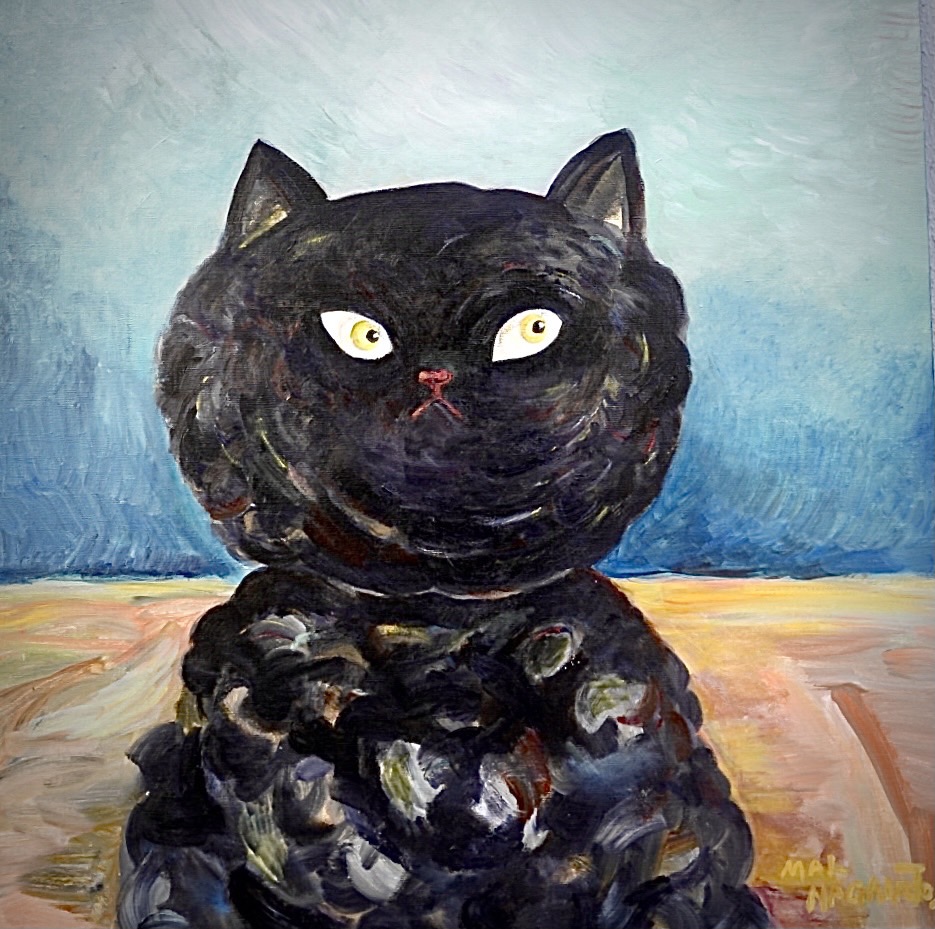
2021/12/15-12/22
A group exhibition
D o N o K o ? Vol.2
Curated by TOKYO URBAN ART , GReeD TOKYO
at @noma__official
ARTIST /
END
MAI NAGAMOTO
Johnny Akihito Noda
YUSUKE BONSAI KID
−作品を拝見させて頂きまして、ここ最近はフテネコの作品が多いのかなと思うのですが、猫は昔から好きだったのでしょうか?
猫は…、3〜4年前に頭が禿げてしまうくらい体調を崩していた時期があって、本当に酷い時はベッドから起き上がれないくらいで…。
当然クリエイティブなことが全くできない、考えられない…みたいな時期でもありました。それでも当時はアート以外に仕事ももっていたので出勤をするのですが、その道すがらに地域猫がいるわけです。だけど最初はあまり好きじゃなくて、なんだったら毎日寝てて「タダで餌もらっていて良いよねぇ」みたいに思っていました(笑)
-I’ve been looking at your works, and I think you’ve been doing a lot of FUTENEKO work lately, but have you always liked cats?
Cats… There was a time three or four years ago when I was so sick that my head was balding, and when it was really bad, I couldn’t even get out of bed.
Naturally, I couldn’t do or think anything creative at all.But at the time, I had a job in addition to my art, so I had to go to work, and there were local cats on the way. But at first I didn’t like them very much, I thought “they were just sleeping around every day and it’s good that they’re getting free food” lol
−あまり好きじゃなかったのは意外ですね(笑)
どんな転機があって好きになったのでしょうか?
毎日「外に出なきゃ」という思いのなかで、ある日家の前の川縁に座っていたら、地域猫が自然に寄ってきて膝に乗ってくれたのがキッカケで…、「暖かい」と(笑) 嬉しくなってしまって。たぶん当時は本当に辛かったのだと思います(笑)
それから毎日、膝に乗ってくれた猫に朝昼晩、必ず同じ時間に会いに行くようになったのですが、猫の方も「来てないかなぁ」みたいな感じになってくれたところが可愛くて。
雨でも雪でも毎日来るようなおじいちゃんとか、その時の私みたいに孤独な人が来ていて、その人たちの背景を自分なりに考えているうちに “またお水が湧くように”クリエイティブができるようになり、その時期から猫の絵を描くようになりました。
もう描かずにいられないわけですよ!好きだから!
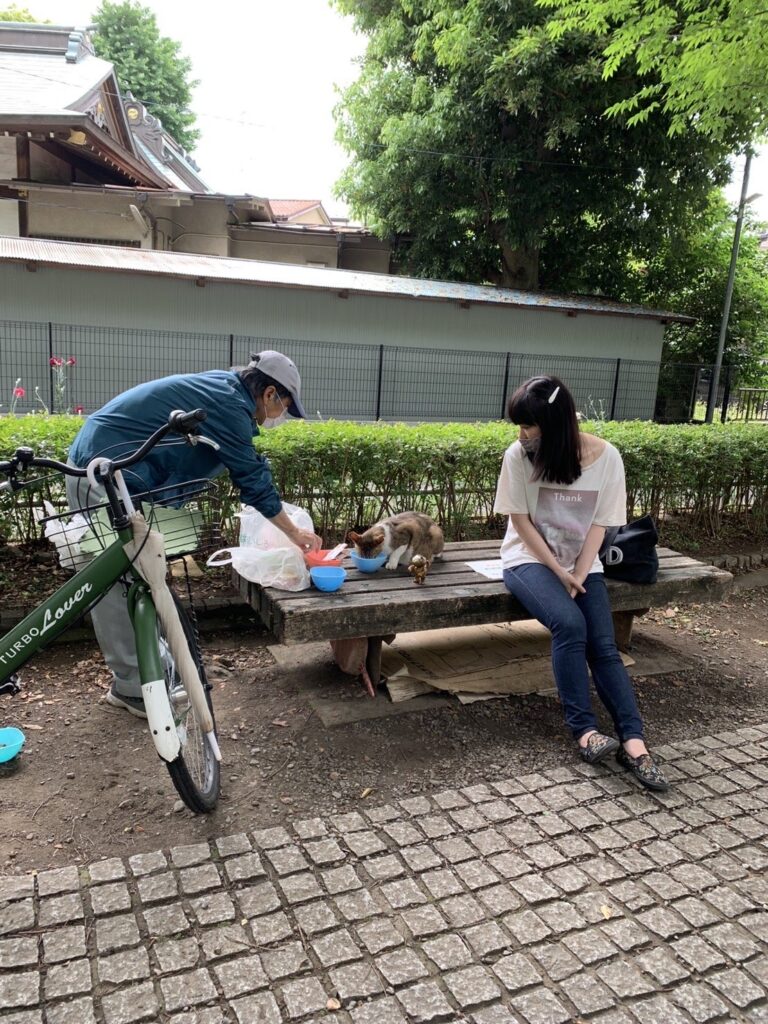
-I’m surprised you didn’t like it much, lol.
What kind of turning point did it take for you to like it?
One day, while I was sitting at the edge of the river in front of my house, a local cat naturally came up to me and sat on my lap. That’s when I realized it was “warm” lol I was so happy. I think it was probably really hard for me at the time
After that, I started going to see the cat on my lap every day, morning, noon and night, always at the same time, and it was so cute that the cat acted like, “I wonder if she’ s here..?”
There was an old man who would come every day, rain or snow, and there were lonely people like me at that time. While I was thinking about their backgrounds in my own way, I was able to be creative again like “water springs”, and that’s when I started to draw cats.
I couldn’t help but draw them! Because I love them!
−地域猫と取り巻く人たちが、作品のインスピレーションになったのですね。
そこから猫も溺愛していくわけです(笑)。
さらに、そこで知り合ったおじちゃんたちのボランティア活動を知ることになったり、日々その場所に通う様になったある日、死にかけの猫を河原で見つけて。すぐに病院に連れて行ったのですが厳しい状況でした。
お医者さまに「あなたが飼うの?飼わないの?」と聞かれて。「飼います!」と答えたのですが、家に連れ帰ったその日の夜に死んでしまいました…。
それで次の日お墓をつくって…、その夜にはフテネコを作っていました。
今までもそうなのですが、私が作るモノには必ずキッカケというものがあって、フテネコの場合はそれがキッカケとなりました。
-The local cats and the people surrounding them became the inspiration for your work.
From there, I started to dote on cats as well lol
In addition, I learned about the volunteer activities of the old men I met there, and I started going to that place every day. One day, I found a dying cat on the riverbank.We took him to the hospital right away, but it was a difficult situation.
The doctor asked me, “Are you going to keep him or not?” I replied, “I’ll keep him!” But he died the same night I brought him home…
So the next day I made the tomb, and that night I made the FUTENEKO.
As has been the case in the past, there is always a motivation for me to make something, and in the case of the FUTENEKO, that motivation became the reason.
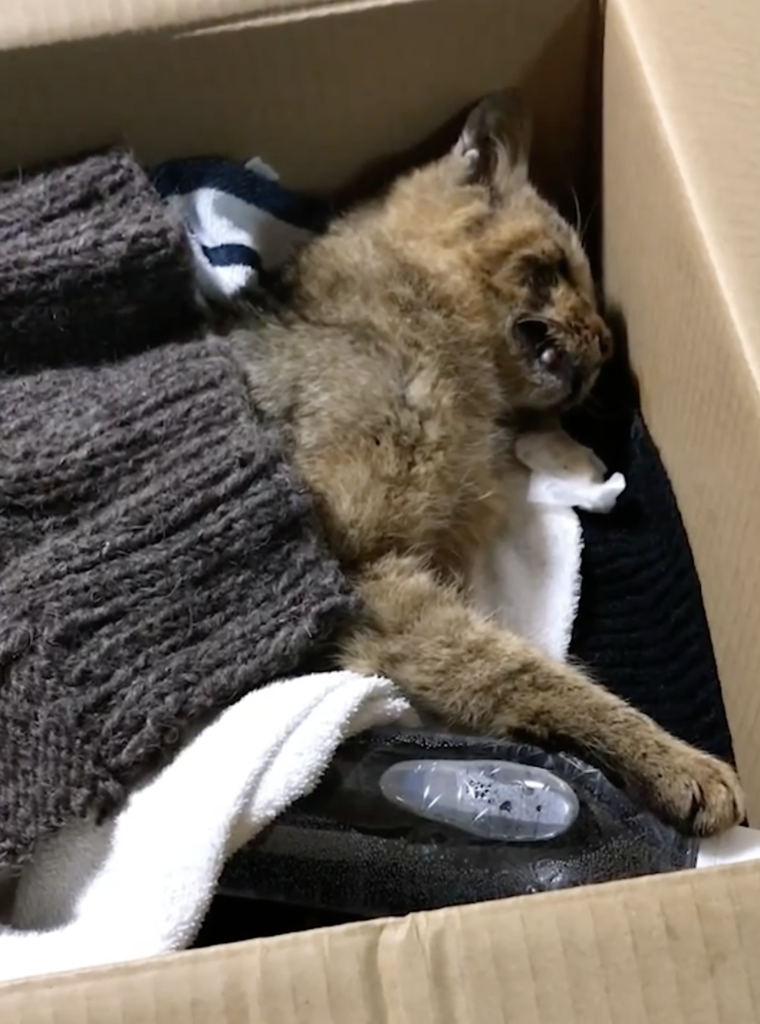

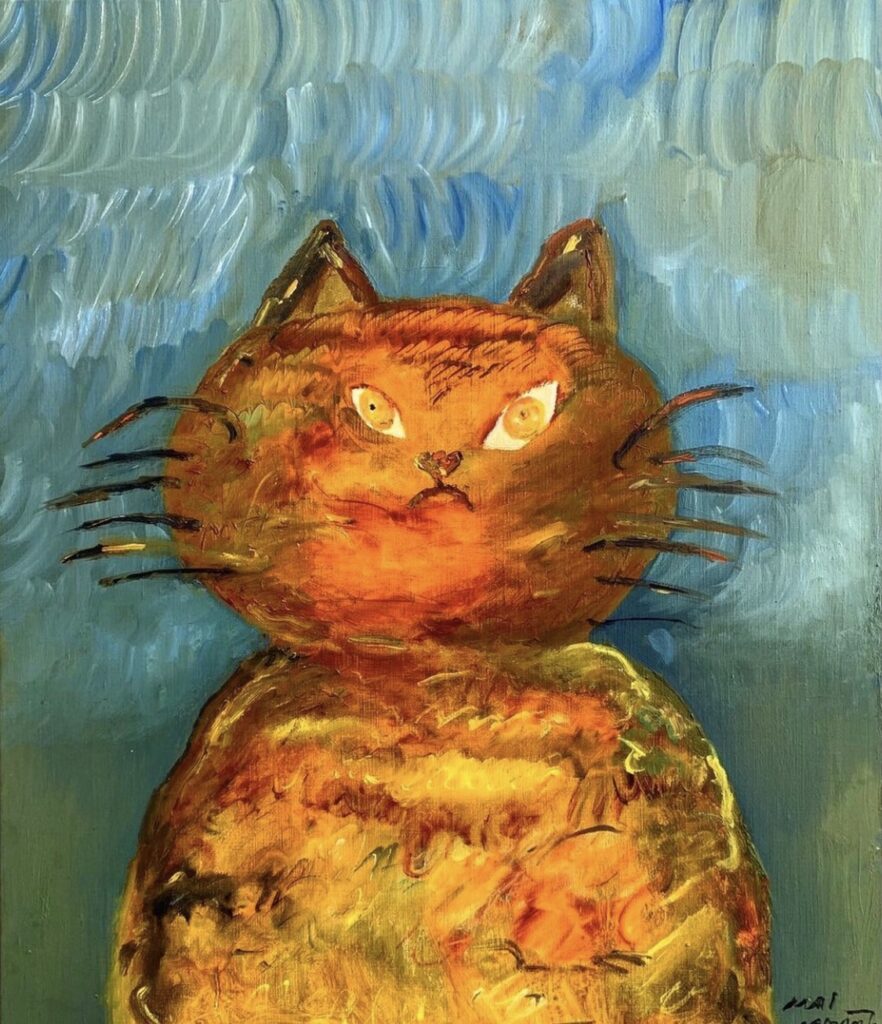
−野良猫に作品作りのインスピレーションになるほどに心惹かれた理由ってなんなのでしょうか?
家猫って外の世界を知らない、穏やかに暮らしてそれはそれで幸せなのかもしれない。
一方で野良猫は強くて自由なんですよ。ふてぶてしさや、たくましさ、家猫と野良猫の顔つきって圧倒的に違うんです。自分は保護猫施設に通っていたのですが、家猫も飼い主からの虐待などで大切にされていなかったり、保護されてくる様な猫には色々と厳しい問題があります。
そんな色々な猫がいるなかで、たくましさって大事だなと思って。
-What is it about a wild cat that fascinates you so much that it inspires you to make art?
Cats that are kept at home don’t know the outside world, they live peacefully and that may make them happy.
On the other hand, wild cats are strong and free. There is an overwhelming difference in the stubbornness and toughness of the faces of house cats and stray cats.I used to go to a shelter cat facility, but even domestic cats are not taken care of due to abuse by their owners, and there are many severe problems with shelter cats.
I thought it was important to be strong in the midst of such a variety of cats.
−フテネコの誕生秘話というか猫をモチーフにしている理由には、ちょっと重たいテーマが背景にあるのですね…。
基本的にモチーフは限定せずになんでも描きますが、なんとなく描くということはできなくて、今は猫が多いですけれども、それらの作品も何かしらキッカケというか衝動があって生まれた作品なんです。
-The story behind the birth of Futeneko, or the reason why it uses cats as its motif, has a rather heavy theme behind it…
Basically, I don’t limit myself to a particular motif, but I can’t just draw whatever I feel like drawing, and although I’m currently drawing a lot of cats, these works were born from some kind of impulse.
−確かにInstagramを拝見すると、フテネコの前は怪獣の作品が多いですよね。
今は猫という具象で描いていますけど、私が表現したいことは私自身の自由な感情表現なので、実はモチーフは何でも良いと言えば良いのですが、抽象的な感情表現をしようとすると、衝動感覚が優先するのでどうしても描くモノも具象ではなくなってしまうんです。
特に昔の作品は何を描いているか良く分からないものが多くて、五感を使って描いていくとファンタジーに行き着いてしまう。だけどファンタジーに寄りすぎないようにもしたくて。何よりも、観てくれる人たちに伝わらない。時間をかけて展示会に通って理解をしてくれる人もいますが、大抵の人は「なんだろう?」で終わっちゃう。
-When I look at your Instagram, I see that before FUTENEKO, you did a lot of work on monsters.
Currently, I draw cats as a figurative subject, but what I want to express is my own free expression of emotions, so I could say that any motif is fine, but when I try to express emotions in an abstract way, my impulsive senses take precedence, so the things I draw inevitably become less figurative.
Especially in my old works, there are many things that I don’t really know what I’m drawing, and if I try to draw with all my senses, I end up with fantasy. But I wanted to make sure that I didn’t go too far into fantasy.Most importantly, the people who see my work don’t get it. There are some people who take the time to come to the exhibitions and understand what I do, but most of them end up asking, “What is it? and that’s it.
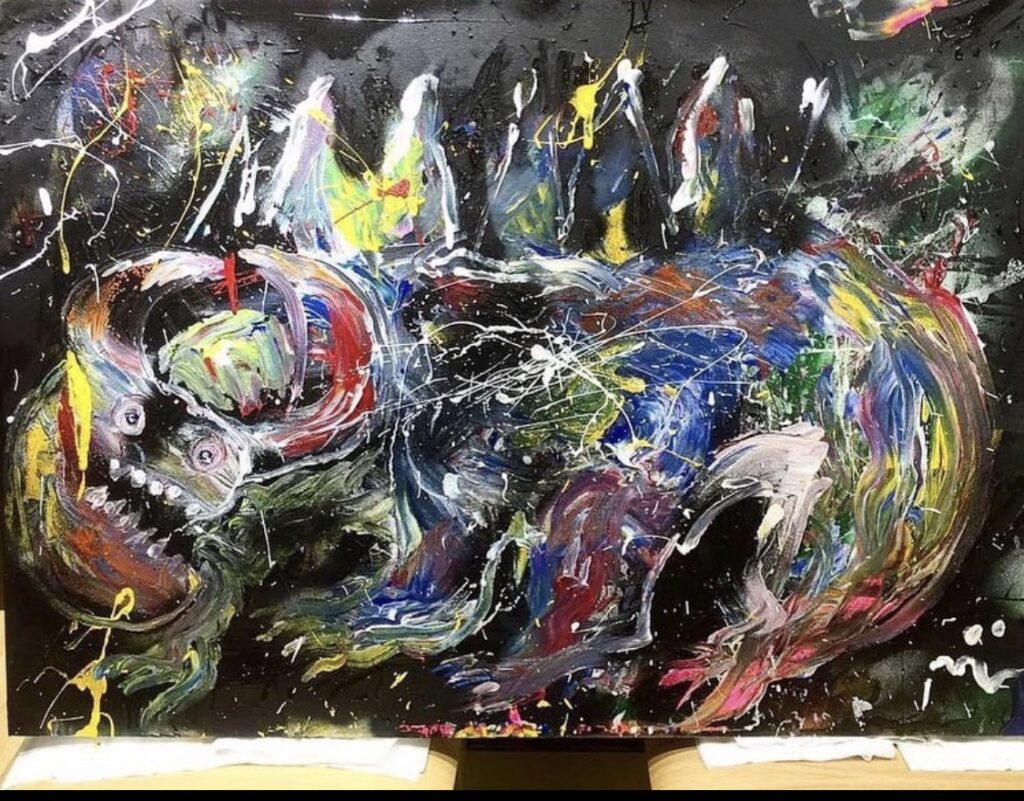
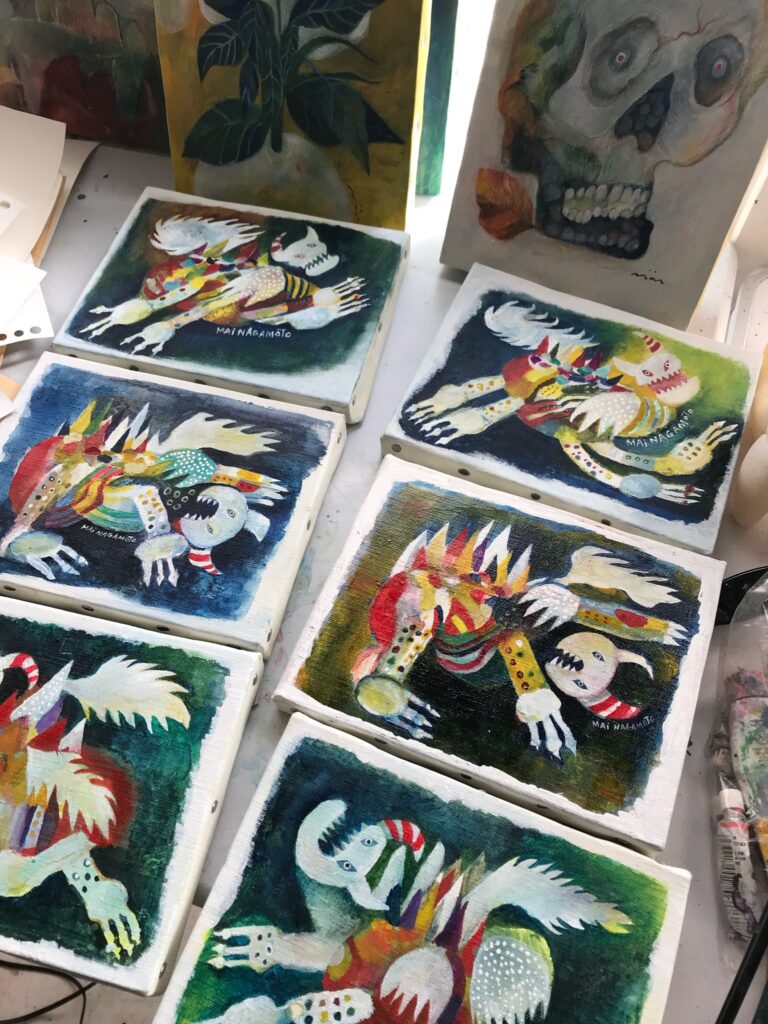
怪獣が描かれている絵。どこかエモーショナルな表現であることは伝わってきます。
A picture with a monster on it. You can tell that it is somewhat of an emotional expression.
−表現の壁にぶつかってしまったわけですね。
結果、反省というわけではないのですが、これでは自分が「先に進めない!」と考えて、もう10年位前の話になりますけれども自問自答をしていきました。
私は、そういう面では現実的に考えるタイプなので、次に進むためにはどうしたら良いのか?という事と真剣に向き合ってきました。
そこで自分らしさを失わずに自分の感情を具象にできないかと考えた時に、“怪獣”が自分の内にある形として出てくるようになりました。
-So you’ve hit a wall of expression.
As a result, not that it was a reflection, but it was about 10 years ago now, and I thought to myself, “I can’t move forward with this!” so I started to ask myself questions.
I’m the type of person who thinks realistically in that aspect, so I seriously faced the question of what I should do in order to move on.
When I thought about how I could give shape to my emotions without losing my own identity, I came up with the idea of a “monster” as a form that was inside of me.
−確かに怪獣は、エモーショナルな部分での象徴という印象を受けます。
私にとって感動というものは、すごく大切なものです。
感動と言ってもそこには怒りとかも含まれていて。正直に言うと、怒りがすごく多いのですけども、怒り、情熱、感動、苦しみとか、そういうものをベースとして描いているからテクニックではないんですよ。だから「どうやって描くの?」と聞かれても答えられない、というか、そもそもそこに重きを置いていないんです。心が大切。そして色です。色は自分の価値観の幅と同じです。とても広く深いもので、重要視しています。
描くうえでの環境や影響されたモノから、色を置いて行き、造作をして行き、そこから見えてくるものを頑張って具象にしていく。
つまり私としては「ノンフィクションのようなものを描いている」と言えます。
-I certainly get the impression that the monster is a symbol of the emotional side of things.
To me, emotions are something that is very important.
But there is also anger in it.To be honest, there’s so much anger, but it’s not a technique because I draw based on anger, passion, emotion, suffering, and so on. So when people ask me, “How do you draw? I can’t answer that question, or rather, I don’t put much emphasis on it in the first place. The heart is important. And color. Color is the same as the width of my sense of value. It’s very broad and deep, and I place a lot of importance on it.
From the environment and the things that have influenced me in drawing, I put down colors, make constructions, and do my best to make the things that I see in them into concrete forms.
In other words, I can say that I am painting something that is like non-fiction.
−ちなみに先ほど発言されていた“伝えきれない”の定義って、ナガモトさんにとってはどの様な事でしょうか?アーティストによって、この定義は幅があるのでお聞きしたいです。
お客様の手にとってもらうこと。つまり購入してもらうこと。そこが私にとっての現実です。
-By the way, what is the definition of “uncommunicable” that you mentioned earlier, for you? I would like to ask this question because this definition varies from artist to artist.
To get the customer to pick up the product. In other words, they buy. That is the reality for me.
−すごく重要であり、ストレートな考えですね…。
はじめは観て感動してもらうだけで良かったのですが、自分は全て独学でやってきたので、それだけではこれ以上先に進めないという現実をいつも感じていました。
余裕のある環境でアートをしてきていれば、繋がりや後ろ盾などにより進むべき道が見えて来るのかもしれませんが、私の場合はそれを自分で見つけて行くので、信頼関係を作るのにも場所を確保するのにも、売り上げという”数字”は欠かせません。
18歳からクラブなどで展示を始めて地上のスペースで展示出来る様になったのも、きっかけは作品が売れたことです。
自分の感動から生まれてきた”怪獣”ですし、心を具象に近づけやすいモチーフでもありますが、描き続ける為に数字を意識しなければならない。その葛藤の先に出てきた”怪獣”でもあるのです。これが正直な話で、普段は人に説明する時は「感動を表現しやすいから」と説明しています。
こういう話をするといやらしく感じる人もいるので控えていますが、購入してもらえる作品を描くということは、私が生きることと直結する部分ですから意識しています。
-It’s a very important and straightforward idea…
In the beginning, all I needed was for people to be impressed by what they saw, but since I was all self-taught, I always felt the reality that I couldn’t go any further with just that.
If you’ve been doing art in a wealthy environment, you may be able to see the path you need to take through connections and backing, but in my case, I have to find it on my own, and sales figures are essential for building trust and securing space.
I started exhibiting at clubs when I was 18 years old, and the reason I was able to exhibit in ground level spaces was because my work sold.
The “monster” was born from my own emotions, and it is also a motif that is easy to bring my heart closer to the figurative, but in order to continue drawing, I had to be conscious of the numbers. The “monster” came out of this struggle.This is the honest truth, and I usually explain to people that it’s because it’s easy to express emotion.
I try to refrain from talking about it because some people find it obscene, but I am conscious of the fact that painting works that can be purchased is directly related to my life.
−根本的な話に立ち返るのですが、衝動を表現したいから絵を描いているのでしょうか?
それもあります。
自分を表現する時に言葉よりも絵や色で現す方が私にとっては自然だったりします。
ですがそれだけではなくて、絵を描く行為によって自分の内側が整理され呼吸がしやすくなりますし、色の数と共に価値観の幅も広がっていきます。
描き続けることで自分なりの哲学も生まれますし、商売になれば生きる知恵も増えていきます。描くことは私の人生そのものだから
「これ!」って言う一つの理由には定められません。
-Going back to the basics, do you paint because you want to express your impulses?
There is also that point.
It is more natural for me to express myself through pictures and colors than through words.
But that’s not all. The act of painting helps me to organize my inner world and breathe more easily, and with the number of colors, my sense of value expands.
As you continue to paint, you will develop your own philosophy, and if it becomes a business, you will gain wisdom for living.Because drawing is my life itself.
I can’t settle on a single reason to say “This is it”.
−“怒り”というキーワードが出てきましたが、どの種類の衝動が一番描く動機になりえますか?
怒りとは、具体的には理不尽さのような事です。人によって色々あると思いますが、世の中や人間関係、それぞれの置かれた環境の中で、抑圧されたり自分が正しいと思う意見が言えなかったり、そういう理不尽さに対する怒りというのが多いと思います。
良いことなのかわかりませんが、私と作品との関係で言うと、すごく自分自身が辛い状況の時の方が良いモノが創造できるように思います…。一方で、立体物やプロダクト、ファッションといったモノを作る時は、みんなの幸せをすごく考えますね。触れた人が「かわいい!癒される」などと感じて、少しでも幸せになってくれることが、私にとっての喜びだと感じています。
でも絵の場合はもう少し深くて、トラウマやカルマの様なものが動機にあります。
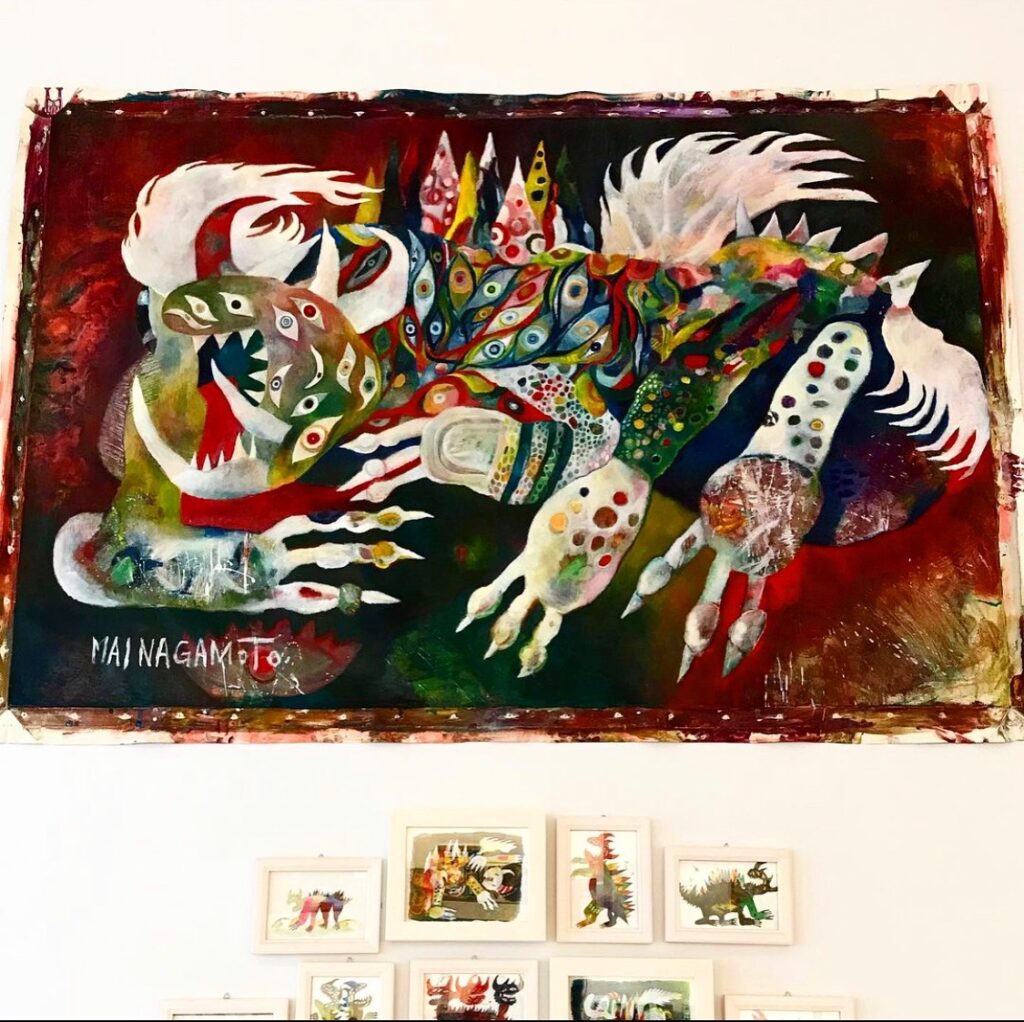
-You mentioned the key word “anger,” but which kind of impulse motivates you to paint the most?
Anger is a specific kind of unreasonableness. It depends on the person, but I think it’s often anger over unreasonableness, such as being oppressed or not being able to express what you think is right in the world, in relationships, or in your own environment.
I don’t know if it’s a good thing, but in terms of my relationship with my work, I think I can create better things when I’m in a very difficult situation…On the other hand, when I create three-dimensional objects, products, and fashion, I really think about the happiness of everyone. If the person who touches it feels cute! It’s comforting! I feel that it is my pleasure to make people feel happy, even if only a little.
But in the case of painting, the motivation is a little deeper, something like trauma or karma.
−Instagramにはウルトラマンの怪獣なども良く出てきますが、昔からその手のものが好きだったのでしょうか?
家庭環境によるものが大きくて、ウルトラマンの怪獣はお兄ちゃんの影響ですね。
自分自身と向き合ってみた結果として家族の影響も大きいな…と思っています。中でも父の影響は大きくて、元々看板職人だったのですが、多分本人も作家や発明家といったクリエイターになりたかった節があって、うちの庭の木にmac book proを飾ってみたり、家のあらゆるところからマネキンの手が飛び出てたりだとか…、いらなくなったメガネに五円玉を貼り付けてお手製のびっくりメガネの様なものを作って子供たちを驚かせてみたりとか、そういうユニークで、でも人としては不器用なお父さんでした(笑)
(そのほかも、すごいエピソードがたくさん出てきたのですが、文章で伝えきれないエピソードが多く割愛…。)
-You often show Ultraman monsters and such on Instagram, have you always liked that kind of thing?
It’s largely due to my family environment, and my brother’s influence on the Ultraman monsters.
As a result of confronting myself, I think that my family has a big influence on me.My father was one of the biggest influences. He used to be a billboard maker, but I think he also wanted to be a writer, inventor, or some other creator. For example, he decorated a mac book pro on a tree in our yard, mannequin hands were sticking out of every part of the house…he even made his own surprise glasses by sticking 5 yen coins on his old glasses to surprise his kids…he was such a unique but clumsy father lol
(In addition, many other amazing episodes came out, but there were too many to tell in writing, so I’ll skip them…)
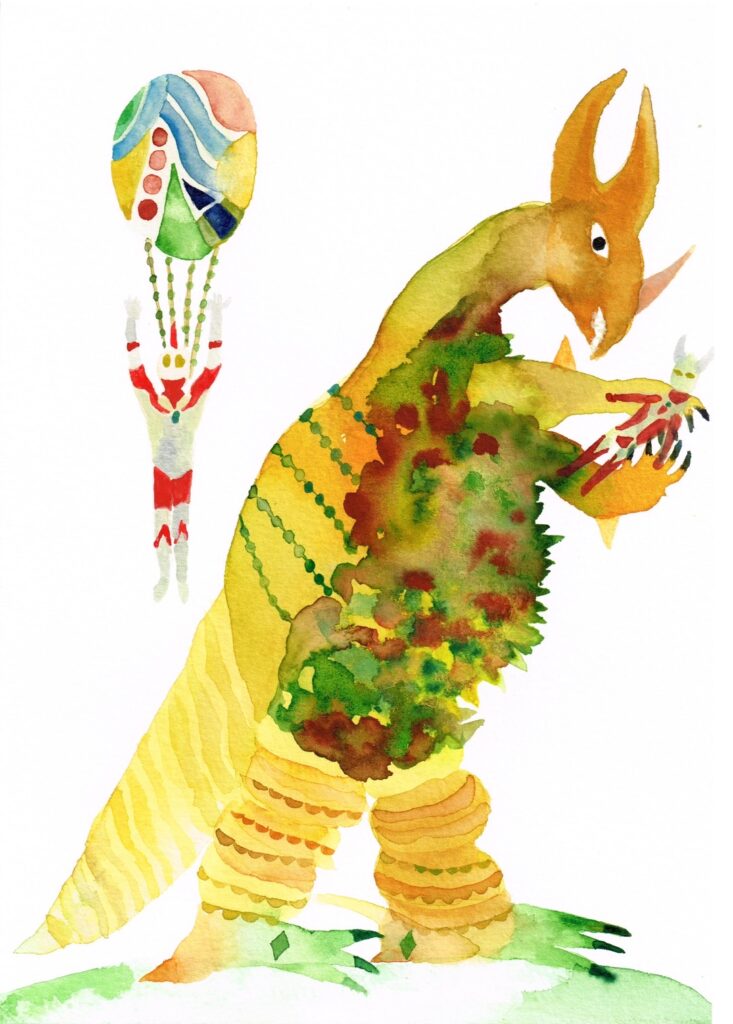
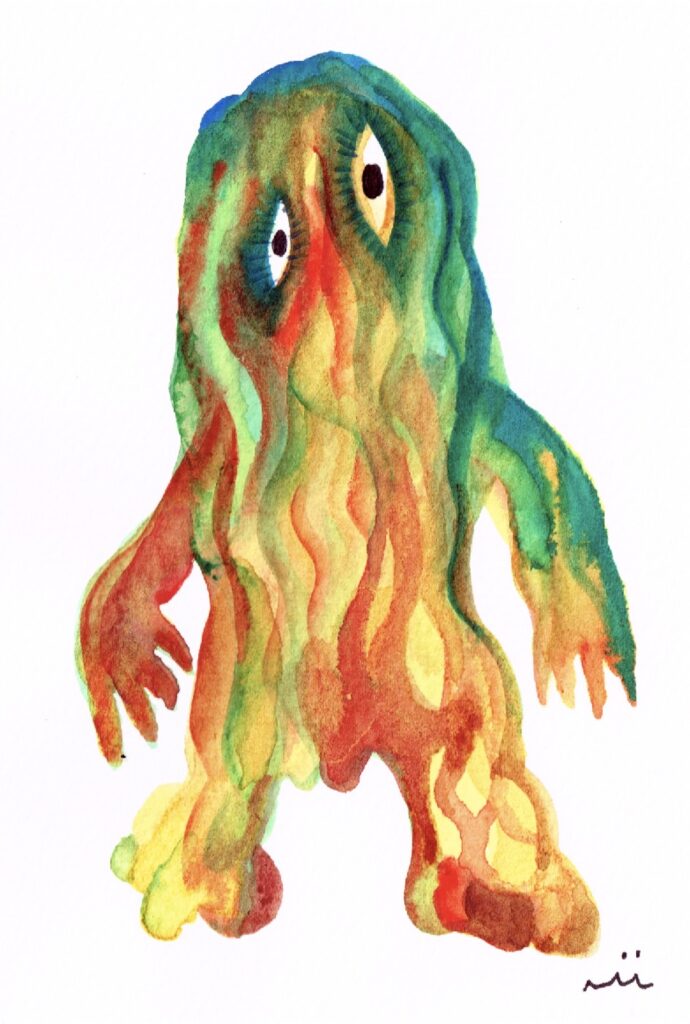
(左)ゴモラとウルトラマン、(右)ゴジラに出てくる怪獣ヘドラ
(left) Gomorrah and Ultraman, (right) Hedorah, the monster from Godzilla.
−面白い方ですね!確かにそれは影響を受けてしまいそうです!
私は大好きでしたが、大人の世界にはちょっと馴染まない…というか。うちは三兄弟なのですが、兄や姉は私ほど意思疎通できていなかったようです。繰り返しますが、そんな不器用な父が私は大好きで、私のクリエイティブの原点はそこだと思っています。
でも一方で、父が「お金にならない事はゴミだ」と言っていて、よく私の絵をゴミだ!!と言っていました。それをずっと言われ続けたことで、傷つきながらもお金についてすごくシビアに考えることができるようになったのだと思います。
ちなみに父が亡くなる直前に色々聞いておかなきゃ!!と思い、「結婚とは?」と聞いたところ、最後の力を振り絞って「騙し合い」って言っていました(笑)
-He is an interesting man! Surely that would have an effect on you!
I loved him, but he didn’t quite fit in with the adult world…or so I thought. I have three siblings, but my brother and sister didn’t seem to be able to communicate as well as I did. Again, I love my father for being such a klutz, and I think that is where my creativity comes from.
But on the other hand, my father used to say that anything that doesn’t make money is garbage, and he used to call my paintings garbage! I think the fact that I was told that all the time made me think very seriously about money, even though it hurt me.
By the way, just before my father passed away, I thought I should ask him some questions, so I asked him, “What is the meaning of marriage?” and with the last bit of strength he said, “Cheating each other” lol
前編はここまでです。それにしても「ハッ!」とさせられることが多かったです。作品自体は表面的にみれば陰はありつつも可愛らしい絵なのですが、背景には鋭さや厳しさがあるわけです。その一端に触れたような気がして、それがとても印象的でした。
さて次回は絵とは別に取り組んでいるソフビの話や、彼女にとって転機になったアートの話などを中心にインタビューを行っていきます。
This is the end of the first part. But still, there were many things that made me wake. On the surface, the work itself is a lovely picture with some shadows, but in the background there is a sharpness and harshness. I felt as if I had come into contact with a part of it, and that was very impressive.
In the next interview, we’ll talk about her work with soft vinyl, which is separate from her paintings, and about art as a turning point for her.
文:THAT IS GOOD編集部:古賀
TEXT : THAT IS GOOD editorial department, Koga
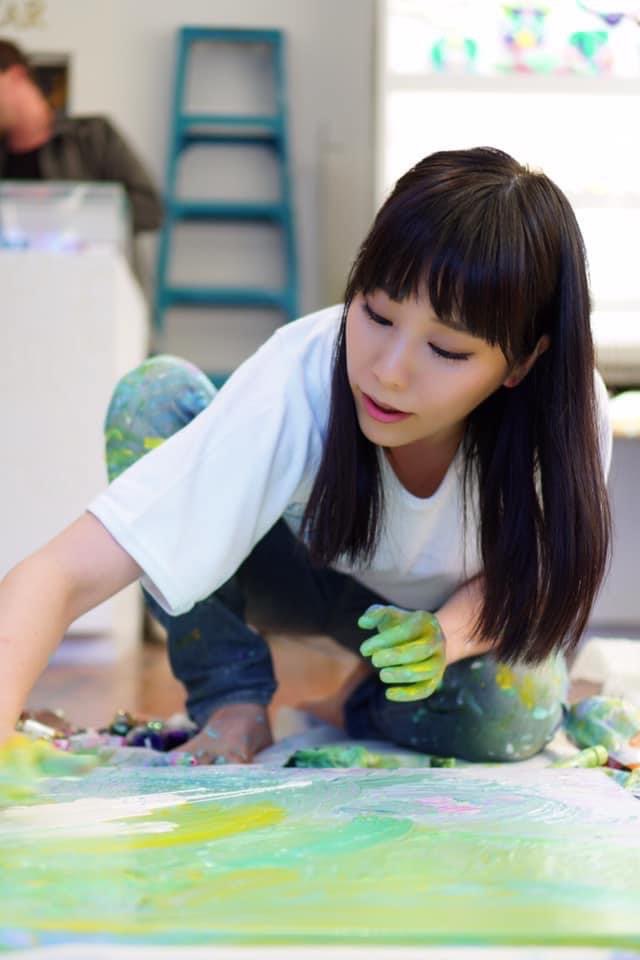
幼い頃から絵が好きで独学で現在に至る。
自身の人生をもとに誰しもが子供の頃に持っていた純真さ無邪気さ、大人になっていくにつれて心の隅に姿を現す陰鬱さをポップな色彩と相反する深く暗い色彩や造形で表現した作品を展開。
2002年から国内外のギャラリーやイベントにて個展を開催。手の平のみで描くライブペイントやオークションにも参加。
(香港.上海.シンガポール.台湾.タイ.サンフランシスコ.LAなど)又、企業との商品企画・監修、コラボレーション、2014年からソフビフィギュアの造形、塗装、販売など商業フィールドも含めて意欲的に活動範囲を拡げている。
She has loved painting since she was a child, and is now self-taught.
Based on her own life, she expresses the innocence and purity that we all had as children, and the gloom that appears in the corners of our minds as we grow older, using pop colors and contrasting deep, dark colors and shapes.
Since 2002, she has held solo exhibitions at galleries and events in Japan and abroad. She has also participated in live painting and auctions using only the palm of her hand.
(Hong Kong. Shanghai. Singapore. Taiwan. Thailand. San Francisco, LA, etc.), as well as product planning and supervision, collaboration with companies, and since 2014, modeling, painting, and sales of soft vinyl figures, she has been ambitiously expanding the scope of her activities to include the commercial field.